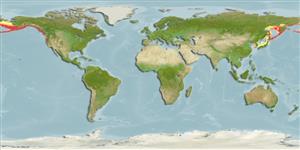Classification / Names
Common names from other countries
Main reference
Size / Weight / Age
Max length : 58.0 cm TL male/unsexed; (Ref. 6885); 60.0 cm TL (female); max. published weight: 1.8 kg (Ref. 56370); max. reported age: 26 years (Ref. 55701)
Length at first maturity
Lm 34.7, range 31 - ? cm
Environment
Marine; demersal; depth range 0 - 575 m (Ref. 6793), usually 0 - 183 m (Ref. 6885)
Climate / Range
Temperate, preferred 4°C (Ref. 107945); 67°N - 34°N, 124°E - 119°W (Ref. 54562)
Distribution
Short description
Dorsal
spines
(total): 0;
Dorsal
soft rays
(total): 65-82;
Anal
spines: 0;
Anal
soft rays: 50 - 65;
Vertebrae: 39 - 42. Dorsal origin over forward part of eye. Caudal with posterior margin a broad 'V'. Pectorals small and may be asymmetrical (Ref. 6885). Blind side white, with glossy highlights along myotome margins, increasing anteriorly. Pores: supraorbital 3-9; preopercular 5-7; lateral line 70-91. Interorbital space narrow (Ref. 37594).
IUCN Red List Status (Ref. 115185)
Threat to humans
Harmless
Human uses
Fisheries: commercial
More information
ReferencesAquacultureAquaculture profileStrainsGeneticsAllele frequenciesHeritabilityDiseasesProcessingMass conversion
Tools
Special reports
Download XML
Internet sources
Estimates of some properties based on models
Phylogenetic diversity index
PD50 = 0.6250 many relatives (e.g. carps) 0.5 - 2.0 few relatives (e.g. lungfishes)
Trophic Level
3.2 ±0.2 se; Based on diet studies.
Resilience
Low, minimum population doubling time 4.5 - 14 years (K=0.15; tm=9; tmax=26)
Vulnerability
High vulnerability (57 of 100)
Price category
